| A | B |
|---|
What is the structure labeled "A"?,  | A flagellum p.100,  |
What is the structure labeled "B"?,  | Endoplasmic reticulum (ER) p.100,  |
What is the structure labeled "B1"?,  | Rough Endoplasmic Reticulum (notice the tiny ribosomes on the ER membrane) p.100,  |
What is the structure labeled "B2"?,  | Smooth Endoplasmic Reticulum (notice the lack of tiny ribosomes on the ER membrane) p.100,  |
What is the structure labeled "C"?,  | Nuclear envelope (a.k.a. - nuclear membrane) p.100,  |
What is the structure labeled "D"?,  | nucleolus p.100,  , , 
|
What is the structure labeled "E"?,  | chromatin p.100,  |
What is the structure labeled "F"?,  | Nucleus p.100,  |
What are the tiny structures labeled "G"?,  | ribosomes p.100,  |
What is the structure labeled "H"?,  | Golgi apparatus p.100,  |
What is the structure labeled "I" that contains digestive enzymes called?,  | lysosome p.100,  |
What is the structure labeled "J"?,  | A mitochondrion p.100,  |
What is the structure labeled "K" that contain the enzyme catalase called?,  | peroxisome p.100,  |
What is the structure labeled "L" that increases the surface area of cells to increase absorption called?,  | microvilli (These are small extensions of the plasma membrane that help increase the surface area of some cells, like intestinal cells, that exchange a lot of materials with their surroundings) p.100,  |
The bracket labeled M is referring to a region called the _____. In this animal cell, two _____ are located in this region.,  | Centrosome, centrioles p.100,  |
The technique shown in the picture below is called _____.,  | cell fractionation p.97,  |
What is the structure labeled "A"?,  | rough endoplasmic reticulum (rough ER) - notice the ribosomes on the membrane folds p.101,  |
What is the structure labeled "B"?,  | smooth endoplasmic reticulum (smooth ER) - notice the lack of ribosomes on the membrane folds p.101,  |
What are the tiny structures labeled "C"?,  | ribosomes p.101,  |
What is the structure labeled "D"?,  | central vacuole p.101,  |
What is the structure labeled "E"?,  | Chloroplast p.101,  |
What is the structure labeled "F"?,  | plasmodesmata (channels through cell walls that connect the cytoplasm of adjacent cells) p.101,  |
What is the structure labeled "G"?,  | Cell wall p.101,  |
What is the structure labeled "H"?,  | plasma membrane (a.k.a. - cell membrane) p.101,  |
What is the structure labeled "I"? Hint: It produces and destroys hydrogen peroxide.,  | peroxisome p.101,  |
What is the structure labeled "J"?,  | A mitochondrion (Remember, plants cells have these too. Even though they make their own food in chloroplasts, if they want to break that food down later for energy, they need to use mitochondria) p.101,  |
What is the structure labeled "K"?,  | Golgi apparatus p.101,  |
What is the region labeled "L" called?,  | centrosome (notice the lack of centrioles in the plant cell) p.101,  |
What is the structure labeled "M"?,  | nucleus p.101,  |
What is the structure labeled "M1"?,  | nuclear envelope (a.k.a. - nuclear membrane) p.101,  |
What is the structure labeled "M2"?,  | nucleolus p.101,  |
What is the structure labeled "M3"?,  | chromatin (uncondensed chromosomes) p.101,  |
What part of the plasma membrane is "A" referring to?,  | hydrophilic region (phosphate heads of the phospholipid) p.99,  |
What part of the plasma membrane is "B" referring to?,  | hydrophobic region (fatty acid portion of the phospholipid bilayer) p.99,  |
What part of the plasma membrane is "C" referring to?,  | hydrophilic region (phosphate heads of the phospholipid) p.99,  |
What is enclosed by the rectangle that "D" is pointing to?,  | a phospholipid p.99,  |
What is "E" pointing to?,  | membrane proteins p.99,  |
What is "F" pointing to?,  | carbohydrate side chains p.99,  |
What type of cell is being shown in this diagram?, 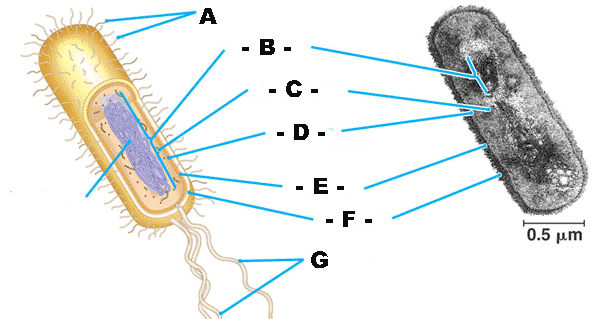 | prokaryotic cell p.98,  |
What is "A" pointing to?,  | pili (the plural of a pilus - they are attachment structures on the surface of some prokaryotes) p.98,  |
What is "B" pointing to?,  | nucleoid (region where the cell's DNA is located) p.98,  |
What is "C" pointing to? Hint: They are tiny dot-like structures.,  | ribosomes p.98,  |
What is "D" pointing to?,  | plasma membrane (a.k.a. - cell membrane) p.98,  |
What is "E" pointing to?,  | Cell wall p.98,  |
What is "F" pointing to?,  | capsule (a jelly-like outer coating found on many prokaryotes) p.98,  |
What is "G" pointing to?,  | flagella (the plural of flagellum) p.98,  |
What type of electron microscope produced this image?,  | scanning electron microscope (SEM) p.96,  |
What type of electron microscope produced this image?,  | transmission electron microscope (TEM) p.96,  |
The cell below is a(n) _____ cell.,  | animal p.100,  |
The cell below is a(n) _____ cell.,  | plant p.101,  |
| The cell is the simplest collection of matter that can ___. | be alive p.94 |
| The ____ is the simplest collection of matter that can be alive. | cell p94 |
| The first microscopes, as well as the microscopes that we use in lab, are called ____. | light microscopes (LM) p.95 |
| ______ in microscopy is the ratio of an object's image size to its real size. | Magnification p.95 |
| _____ is a measure of the clarity of an image under a microscope and is defined as the minimum distance that ______ can be separated and still be distinguished as _____. | Resolution, two points, two points p95 |
| Light microscopes can magnify effectively to about ______ X before sacrificing resolution. | 1000X p.95 |
| _________ microscopes focus a beam of electrons through the specimen or onto its surface. | Electron microscopes p95 |
| A disadvantage of electron microscopes is the fact that you can't __________. | view live specimens with them. (The preparation of the specimen kills the specimen) p95-96 |
| The type of electron microscope that produces 3-D images of the surface of a specimen is called a ____. | scanning electron microscope (SEM) p95,  |
| The type of electron microscope that produces a two dimensional picture of a thinly sliced cross section of a specimen is called a ______. | transmission electron microscope (TEM) p95 |
| The study of cells is called _____. | cytology p97 |
| The goal of the laboratory technique called _____ is to take cells apart and separate the major organelles from one another. | cell fractionation p97 |
| The basic structure and functional unit of every organism is one of two types of cells; _____ or _____. | prokaryotic or eukaryotic p98, 
|
| Only organisms of the domains _____ and _____ consist of prokaryotic cells. | Bacteria and Archaea p.98 |
| What are four features that all cells, whether prokaryotic or eukaryotic, have in common? | Plasma membrane, cytosol, ribosomes, and chromosomes (although the structure of eukaryotic and prokaryotic chromosomes are quite different) p.98 |
| The semifluid, jellylike substance in which organelles are found is called _____. | cytosol p.98 |
| A major difference between prokaryotic and eukaryotic cells is the _________. | location of the DNA (eukaryotic chromosomes are located within a nucleus while prokaryotic chromosomes are out in the cytosol in a region called the nucleoid) p.98 |
| The entire region between the nucleus and the plasma membrane in eukaryotic cells is called the ____. | cytoplasm (which includes the cytoplasm and the organelles, other than the nucleus) p.98, 
|
| The major reason that cells can't get too big is that as they get bigger, their _____ grows faster than their ____. | volume grows faster than their surface area (A cells requirement for nutrients and production of waste is proportional to its volume, but its ability to get nutrients in and waste out through the plasma membrane is proportional to the surface area of the plasma membrane) p.99 |
| Which three organelles or cell parts can be found in an animal cell but not in a typical plant cell? | lysosomes, centrioles, and flagella (although some plant sperm have flagella) p.100 |
| Which four organelles or cell parts are found in a plant cell but not an animal cell? | chloroplasts, large central vacuole, cell wall, plasmodesmata p.101 |
| The ________ directs protein synthesis by synthesizing m-RNA according to instructions provided by ______. | nucleus, DNA p.102 |
| The nucleus is enclosed by a double membrane called the ______ which has holes called _____ to allow materials back and forth between the cytoplasm and the interior of the nucleus. | nuclear membrane, nuclear pores p.102-103 |
| DNA in the nucleus of eukaryotic organisms is located inside the nucleus as discreet units called _____. They are only clearly visible just before _____. Otherwise, they are uncoiled in a diffuse mass referred to as _____. | chromosomes, cell division, chromatin. p.102 |
| The dark structure inside the nucleus is called the _____. It's job is to make the large and small subunits of ______. | nucleolus, ribosomes p.102, 
|
| Ribosomal RNA (r-RNA) is synthesized inside the _____ and then assembled with proteins to make the _____ and _____ subunits of _______. | nucleolus, large and small subunits of ribosomes (These two subunits aren't put together to form a functional ribosome until they leave the nucleus and enter the cytosol) p.102 |
| ________ are particles that carry out protein synthesis when _____ attaches to them to deliver the instructions. | Ribosomes, m-RNA p.102 |
| Cells that have high rates of protein synthesis would have a large number of ______. | ribosomes p.102 |
| Where would find free ribosomes ____________. | suspended in the cytosol p.102 |
| Bound ribosomes would be found attached to the outside of the _____ or the _____. | endoplasmic reticulum or nuclear envelope p.102 |
Which process is depicted in the picture below?, 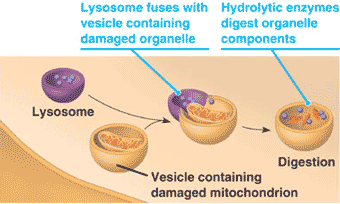 | Autophagy (the recyling of old cell parts) p.107,  |
Which organelle is the arrow pointing to in the micrograph?,  | The central vacuole of a plant cell p.108,  |
The "A" is pointing to ____ in the picture below.,  | chloroplast DNA (both chloroplasts and mitochondria have DNA of their own. It's thought to be strong evidence of the bacterial origin of these organelles) p.111,  |
The "B" is pointing to ____ in the picture below.,  | the stroma of a chloroplast (like the cytosol of the chloroplast) p.111,  |
The "C" is pointing to ____ in the picture below.,  | the inner and outer membranes of the chloroplast p.111,  |
The "D" is pointing to ____ in the picture below.,  | a granum in a chloroplast(singular of grana) - a granum is a stack of thylakoids. p.111,  |
The "E" is pointing to ____ in the picture below.,  | a single thylakoid in a chloroplast p.111,  |
The micrograph below is that of a(n) ______.,  | chloroplast p.111,  |
What are the "A's" in the picture below?,  | transport vesicles p.108,  |
What is the "B" in the picture below?,  | The endoplasmic reticulum p.108,  |
What is the "C" in the picture below?,  | The golgi apparatus p.108,  |
What is the "D" in the picture below?,  | a bound ribosome (the little red dot) p.108,  |
The micrograph shows ______., 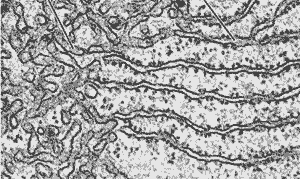 | endoplasmic reticulum (most of it is rough ER. The little dots are ribosomes) p.104,  |
The micrograph shows ______., 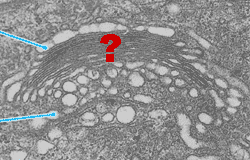 | golgi (the bubbles on either side are transport vesicles) p.106,  |
The organelle surrounding the mitochondrion and peroxisome fragments in the micrograph below is a(n) _____.,  | lysosome (the lysosome is performing autophagy, which is the destruction and recycling of old cell parts) p.107,  |
What is "A" in the picture below?,  | A mitochondrion p.110,  |
What is "B" in the picture below?,  | the intermembrane space of the mitochondrion p.110,  |
What is "C" in the picture below?,  | the outer membrane of the mitochondrion p.110,  |
What is "D" in the picture below?,  | The inner membrane of the mitochondrion p.110,  |
What is "E" in the picture below?,  | Cristae of the mitochondrion (folds of inner membrane) p.110,  |
What is "F" in the picture below?,  | the matrix of the mitochondrion (the inner compartment) p.110,  |
What is "G" in the picture below?,  | mitochondrial DNA (both chloroplasts and mitochondria have DNA of their own. It's thought to be strong evidence of the bacterial origin of these organelles) p.110,  |
Which organelle is shown in this micrograph?,  | a mitochondrion p.110,  |
Which cellular structure are the question marks referring to?, 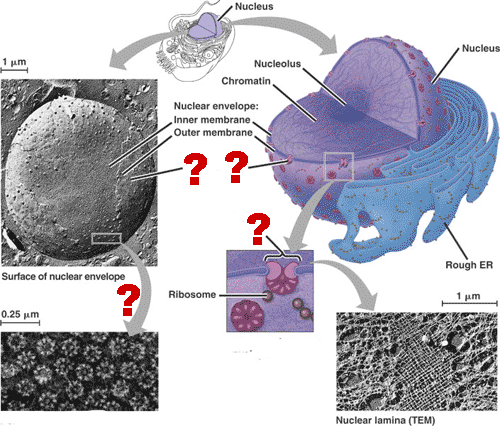 | nuclear pore p.103,  |
Which process is being shown in the picture below and what are the two organelles (A and B) involved?,  | Phagocytosis (A is a lysosome and B is a food vacuole) p.107,  |
What is "A" pointing to?,  | rough endoplasmic reticulum p.104,  |
What is "B" pointing to?,  | free ribosomes p.104,  |
What is "C" pointing to?,  | bound ribosomes (they are bound to the outer part of ER membrane) p.104,  |
| The nuclear membrane, ER, golgi, lysosomes, vacuoles and plasma membranes are all part of the ________. | endomembrane system p.104 |
| Transport of substances between various parts of the endomembrane system are usually carried out by _______. | transport vesicles p.105 |
| The ER membrane is continuous with the _____. | nuclear envelope p.104 |
| The ______ ER does not have ribosomes attached to its outer surface. | smooth p.105 |
| The ______ ER has ribosomes attached to its outer surface. | rough p.105 |
| The smooth ER does not have ________ attached to its outer surface. | ribosomes p.105 |
| The rough ER has ________ attached to its outer surface. | ribosomes p.105 |
| Which organelle is important in the synthesis of lipids, including steroid hormones, as well as phospholipids for membranes? | Smooth ER p.105 |
| The _______ has enzymes that help detoxify drugs and poisons, especially in liver cells. | smooth ER p.105 |
| Most proteins that end up being secreted out of cells were originally made in the _____. | rough ER p.105 |
| Many proteins made on ribosomes on the rough ER enter the ER lumen and have carbohydrate portions attached to them to form ______. | glycoproteins p.105 |
| Which organelle makes membranes for the cell and its various membrane bound organelles? | Rough ER p.105 |
| The _____ can be thought of as a center for warehousing, sorting, and shipping, and even some manufacturing. | golgi apparatus p.105 |
| Transport vesicles that bud off the golgi to deliver molecules to the outside of the cell will _____ with the plasma membrane. | fuse pp. 105-106, 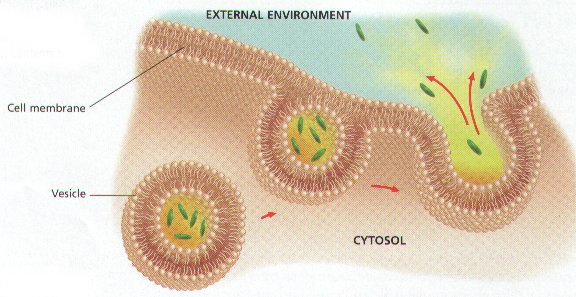 |
| A(n) _____ is a membranous sac of hydrolytic enzymes that an animal cell uses to digest all kinds of macromolecules. | lysosome p.106 |
| When lysosomes fuse with food vacuoles that are formed by endocytosis, the overall process of procurring and digesting the food is called ______. | phagocytosis p.107,  |
| Phagocytosis involves the fusion of which two organelles? | a lysosome and a food vacuole p.107,  |
| Lysosomes can use their enzymes to break down and recycle the cell's own molecules and cell parts in a process called _____. | autophagy (phage means eat and auto means own) p.107,  |
| Mature plant cells contain a large _________ enclosed by a membrane called a tonoplast. | central vacuole p.108 |
| Many freshwater protists contain a _____ vacuole that pumps water out of the cell. | contractile vacuole (The contractile vacuole in the paramecium below is the star-shaped organelle in the upper right end of the cell) p.108,  |
| The ____ and _____ are organelles that convert energy into more useable forms for eukaryotic cells. | mitochondria and chloroplasts p.109 |
| Which two organelles have their own ribosomes and DNA that are different from the rest of the cell's DNA and ribosomes? | mitochondria and chloroplasts p.109 |
| Which organelle is involved with cellular respiration? | mitochondria p.109 |
| The mitochondria is involved with the process of _____. | cellular respiration p.109 |
| The chloroplast is involved with the process of _____. | photosynthesis p.109 |
| Which organelle is involved with photosynthesis? | chloroplast p.109 |
| The space between the inner and outer membranes of the mitochondria is called the _____. | intermembrane space p.109,  |
| The space inside of the inner membrane of the mitochondria is called the ____. | mitochondrial matrix p.110,  |
| Amyloplasts (that store starch), chromoplasts (that store color pigments) and chloroplasts (photosynthesis) are types of plant cell organelles called _____. | plastids p.111 |
| The flattened interconnecting sacs inside chloroplasts are called ____. | thylakoids ("E" in the picture below) p.111,  |
| A stack of thylakoids is called a ______. | granum ("D" in the picture below) p.111,  |
| The space between the thylakoids and the inner membrane of the chloroplast is called the ____. | stroma p.111 |
| The green photosynthetic pigment in _____ is called _____. | chloroplasts, chlorophyll p.110 |
| _____, especially prominant in the liver, help detoxify alcohol and other poisons by transferring hydrogen from the poisons to oxygen, producing hydrogen peroxide. | Peroxisomes p.111 |
| Some peroxisomes help break down the type of macromolecule called _____ by oxidation, which produces hydrogen peroxide as a byproduct. | lipids p.111 |
| Hydrogen peroxide produced in peroxisomes during oxidative reactions is quickly broken down by ____, also produced by peroxisomes. | catalase (This info is not in the chapter, but it is the enzyme we are doing a major research project on, so you should know it) |
| The _______ is a network of fibers that organizes structures and activities of the cell. | cytoskeleton p.112, 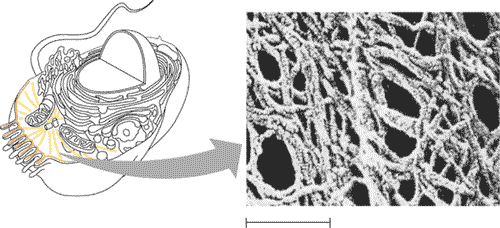 |
| The cytoskeleton is composed of three types of molecular structures. From widest to narrowest, they are _______, _______, and _______. | microtubules, intermediate filaments, and microfilaments pp.112-113 |
| Another word for microfilaments is ______ filaments. | actin (Actin filaments are a key component of muscle fibers) p.113 and p. 116 |
| Cell motility generally requires the interaction of the cytoskeleton with proteins called _____ that help them move. | motor proteins p.112 |
| ______ shape and support the cell and also serve as tracks along which organelles equipped with motor proteins can move. | Microtubules p.114 |
| ______ are responsible for the separation of chromosomes during cell division. | microtubules p.114 |
| In many cells, microtubules grow out from a region called the ______, and is considered to be the "microtubule organizing center." In animal cells a pair of centrioles would be found in this region. | centrosome p.114 |
| Within the centrosome of animal cells are a pair of ______ that seem to help with separation of chromosomes during mitosis. | centrioles p.114 |
| Many single-cell organism have either _____ or ______, both with the same "9 + 2" arrangement of microtubules, to help propel them through the water. The ____ are the longer of the two. | cilia, flagella, flagella are longer (The picture below is a photosynthetic protist called Euglena that uses its flagellum to move through water) p.114,  |
| The microtubule assembly of cilia or flagella is anchored to the cell by the ______, which is structurally identical to a centriole. | basal body (In humans as well as many other animals, the basal body at the base of the sperm's flagellum enters the egg and becomes a centriole) p.116,  |
| Microfilaments (actin filaments) often work in conjunction with a protein called _____ to cause contraction in such things as muscle cells, pinching of the cleavage furrow during cytokinesis, or movement of pseudopods in amoebae. | myosin p.117, 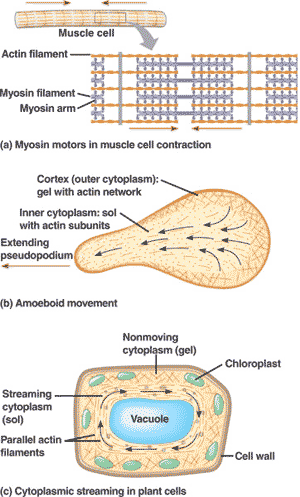 |
| ______ are the most permanent of the three types of cytoskeleton structures and often are responsible for holding the shape of a cell or keeping organelles in place. | Intermediate filaments (Intermediate filaments surround the nucleus and strengthen long nerve cells for example) p.118 |
| The cell wall of plants is made mostly of ______. | cellulose p.118 |
| The thin layer that glues plant cells together is called the ____. | middle lamella p.119 |
| Plant cell walls are commonly perforated by channels between adjacent cells called _____ that allow cytoplasmic substances to go back and forth from one cell to the next. | plasmodesmata p.120 |
| The most abundant extracellular glycoprotein is _____. | collagen (a type of connective tissue fiber) |
| _____ are a type of receptor protein that spans the plasma membrane and facilitates communication from the extracellular matrix to the cytoskeleton on the inside of the cell. | Integrins p.120 |
| In animal cells, the three main types of intercellular junctions are ____, _____, and _____. | tight junctions (A), desmosomes (B), and gap junctions (C). p.121,  |
What type of intercellular junction is "A" referring to?,  | tight junction p.121,  |
What type of intercellular junction is "B" referring to?,  | desmosome p.121,  |
What type of intercellular junction is "C" referring to?,  | gap junction p.121,  |
| In animals, which type of intercellular junction functions like a channel that allows the transfer of small molecules between cells to occur and also allows neighboring cells to communicate with each other? | gap junction (C in the picture below) p.121,  |
| In animals, which type of intercellular junction function like rivets that fasten neighboring cells together? | desmosomes (B in the picture below) p.121,  |
| In animals, which type of intercellular junction function sews cells together to prevent extracellular fluid from leaking across layers of epithelial cells? | tight junctions (A in the picture below) p.121,  |
Which two types of cellular structures would have a cross-section like the picture below?,  | Basal bodies and centrioles (notice the nine sets of triplet microtubules) pp.115-116,  |
Which two types of cellular structures would have a cross-section like the picture below?, 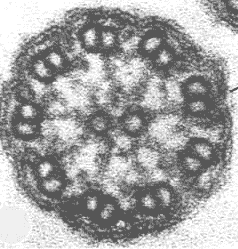 | cilia and flagella (notice the nine pairs wrapped around two microtubules construction, often referred to as a "9+2 construction.") pp.114-116,  |
| The aspect of microscopy that refers to the ability of things you are looking to stand out from their surroundings is called ________. | contrast p.95 |
| In prokaryotic cells, where is the DNA located? | In the nucleoid region out in the cytosol p.98 |
| In eukaryotic cells, where is the DNA located? | In the nucleus (although some organelles, like chloroplasts and mitochondria, contain small amounts of their own DNA) p.98 |
| The major difference between prokaryotic and eukaryotic cells is that prokaryotic cells do not store their DNA inside a(n) ____ and they lack other ____ organelles as well. | nucleus, membrane-bound organelles (Ribosomes, which are found in both types of cells, are not membrane-bound. Instead, they can best be described as solid structures with no interior region) p. 98 |
| The ____ face of the golgi is the "receiving side" since it receives products from the ER via transport vesicles. | cis pp. 105-106 |
| The ____ face of the golgi is the "shipping side" since it packages golgi products into transport vesicles that often times fuse with the cell membrane to release the products to the outside of the cell. | trans pp. 105-106 |
| Individual sacs of the golgi can be referred to as _____. | cisternae p.105 |
| What would the pH in a lysosome be like compared to the pH of the rest of the cytosol? | lower/acidic (The hydrolytic enzymes used inside lysosomes work best at low pH, so the lysosome acts like a little compartment where hydrogen ions can be concentrated in order to help the enzymes work better) p.106 |
| What does the root word "cyto-" mean? | Cell (For example, cytology is the study of cells |
| What does the root word "extra-" mean? | outside (For example, extra cellular refers to something just outside the cell, like the extracellular matrix) |
| What does the root word "glyco-" mean? | sweet (For example, a glycoprotein is a molecule that is part protein and part carbohydrate. When you think of sweet, think of sugar which is a carbohydrate) |
| What does the root word "pseudo-" mean? | false (Since "pod" means foot, a pseudopod means "false foot." Amoebas, like the one below, have pseudopods. They are the extensions of the cell that expand and contract to help the amoeba move around and grab food particles to phagocytize),  |